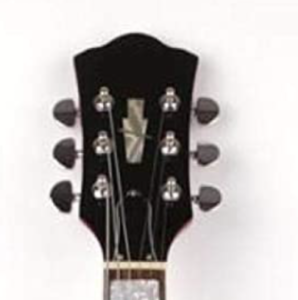Fret Buzz is the noise that you get from the guitar when you strum the strings.
There are several ways to solve the fret buzz problem, but some of them involve a lot of time and possibly some modifications to your guitar.
So, in the end it is frequently easier just to buy a better quality guitar that still fits in your budget. Check here to see these guitars that will not have fret buzz problem, and solve the issue that you might have.
Changing the Guitar Neck
 A possible way to solve the fret buzz problem is fixing the guitar neck. Some guitar necks are made of poor quality woods, and with time they bend out of shape. This generates a lot of buzz noise, that make it difficult to play the instrument. It also causes string to ring in an uncomfortable way.
A possible way to solve the fret buzz problem is fixing the guitar neck. Some guitar necks are made of poor quality woods, and with time they bend out of shape. This generates a lot of buzz noise, that make it difficult to play the instrument. It also causes string to ring in an uncomfortable way.
The solution in this case is to buy a guitar neck (that you can find in some online stores). Once you get a new, good quality neck, you can replace it with a screw driver and fix the buzz issue. To check that the fix worked, make sure that you get the guitar in tune and check if has stop with fret buzz.
Hot Tip: Learn more about different guitar parts here.
Leveling the Guitar Frets to Reduce Fret Buzz
Another possible way to solve the buzz problem in your guitar is to re-level the guitar frets. This means that you want to measure the position of the frets, and file the ones that are out of position, so that they will stop generating the buzz noise.
Leveling the guitar is a time consuming operation that requires a lot of attention. If you don’t have skill for this kind of work, there is the possibility of getting a certified person to check your guitar and change the leveling of the frets.
Also Read:
Guitar Intonation: What it is and How to Fix
Guitar Humidifiers: Hot Buying Secrets
Guitar Neck Shims: Learn the Secrets
5 Secrets for How to Teach Yourself Guitar
Guitar String Notes: Easily Finding Them
Acoustic Guitar String Buzz
 String buzz is also a common problem with acoustic guitars. The problem happens mostly with cheap, entry level instruments.
String buzz is also a common problem with acoustic guitars. The problem happens mostly with cheap, entry level instruments.
However, you can also have problems with expensive acoustic guitar, if they are not well set up. You start having a string buzz that reduces the quality of the sound.
Solving the problem with acoustic guitars is similar to electric guitar. However, it takes a little more care than with electric ones.
The issue is that an acoustic guitar is more delicate, and you need to be careful not to damage the neck or the top of the acoustic surface.
Changing the Truss Rod Tension
 Another approach that may well work for fixing the fret buzz issue is to change the tension of the truss rod. This can be a way to solve the issue for most electric guitars and for some acoustic ones.
Another approach that may well work for fixing the fret buzz issue is to change the tension of the truss rod. This can be a way to solve the issue for most electric guitars and for some acoustic ones.
The Truss Rod is a device that exist in most electric and some acoustic guitars and that allows one to adapt the arch or the guitar neck, which can change the distance between the strings and the fretboard.
 The truss rod is a metal rod that reinforces the neck of most electric and some acoustic guitars. The truss rod can be regulated using an adjustment bolt. Most models have an adjustment bolt visible from a hole in the guitar headstock.
The truss rod is a metal rod that reinforces the neck of most electric and some acoustic guitars. The truss rod can be regulated using an adjustment bolt. Most models have an adjustment bolt visible from a hole in the guitar headstock.
The string ringing is frequently related to a small distance between the strings and the fretboard. By adjusting the truss rod, one can change this distance and make you guitar sound better.
To perform the adjustment, you need to turn the adjustment bolt clockwise or counterclockwise. This will change the tension of the truss rod, and therefore alter the shape of the guitar net, therefore avoid some types of string buzz.
If you decide to adjust the truss rod, however, make sure that you only make small adjustments. A large change in the truss rod may increase the tension and damage or break the guitar neck. This will not solve the fret buzz and ruin your guitar.
Change the Height of the Bridge or Saddle

Guitar Saddle
Another approach to avoid fret buzz is to change the height of the bridge or saddle.
The bridge is the tail piece where the strings are connected. It supports the tension of the strings, and is made of metal in most electric guitars. The saddle is normally responsible for the guitar intonation, and should be adjusted to avoid intonation problems.
The guitar may also have a saddle: a second piece generally of metal that supports the strings between the bridge and the rest of the guitar body.
Hot Tip: to learn more about guitar saddle, take a look at our tips about this topic.
Depending on the model, these pieces will have height adjustment screws. For example, the Fender Stratocaster has a complex bridge with individual adjustment for string height. The Gibson instead has a separate saddle that has the height adjustments.
In any case, you can use a Phillips screw driver to change the height of strings.
The higher the string, there is less chance the strings will have to meet the fretboard and make the buzz sound.
The lower the string, there is more chance that the strings will meet the fretboard, causing noise.
The goal is to find the sweet spot where the strings will have good action (that is, are easy to handle) and still avoid the buzz noise.
Why is my Guitar Bridge Buzzing?
 An annoying occurrence with some types of guitar is that the buzzing, the unwanted noise, occurs at the bridge.
An annoying occurrence with some types of guitar is that the buzzing, the unwanted noise, occurs at the bridge.
The guitar bridge is a location where you may have problems that cause the buzzing you hear.
For example, the bridge may be of a low quality material, and it therefore is interacting with the strings.
To avoid problems with you bridge, check if it is correctly polished or if there is any small portion of it sticking out.
One possible way to deal with it is to file the bridge using sand paper, for example.
If you cannot polish, probably you can buy a new bridge (they’re usually cheap in most online websites or guitar stores).
File the Guitar Frets
 Another possible reason for the buzz sound in your guitar strings is that some frets may be uneven. The solution for this is to use sand paper or a similar tool to file the fret, until it becomes even with the others.
Another possible reason for the buzz sound in your guitar strings is that some frets may be uneven. The solution for this is to use sand paper or a similar tool to file the fret, until it becomes even with the others.
This is an adjustments that requires you to remove the guitar strings first. Then, you need to use some sand paper to file the frets that need to be calibrated.
What If Fret Buzz Occurs on One Fret?
Sometimes, if you have fret buzz problems in a guitar, the issue may be concentrated in a single fret.
When this happens, it is possible to improve the situation fixing this particular fret, while the rest of the guitar neck will remain untouched.
To fix a particular fret, you may start polishing and filing this fret. Try to do this slowly, because you don’t want to overdo the filing of the metal.
If doing this doesn’t work, the last option is to replace the fret. There may be a problem in the existing fret that prevents it from being leveled to the strings.
Fret Buzz Occurring on Lower Frets
 Another common situation is having fret buzz happening only on the lower frets.
Another common situation is having fret buzz happening only on the lower frets.
This happens when the strings are very close to the neck in the region of the lower frets. A reason why this might be happening is insufficient height in the nut.
The nut piece may have insufficient height by construction (in this case it was always a problem), or because it was worn out from too much playing.
A solution, in this case, is to fix the nut to increase the height at the lower part of the scale. You have a few options for this.
The simplest option is to use some material in the slots, so they will be raised. You can put some small piece of plastic, for example.
A better solution is to replace the nut completely. A new guitar nut is cheap, and it is not difficult to replace. You just need to remove it with pliers, and use glue to fix the new nut in place.
Fret Buzz on Higher Frets
 You can also have the opposite problem: high fret buzz, occurring on the frets closer to the bridge.
You can also have the opposite problem: high fret buzz, occurring on the frets closer to the bridge.
This is a situation that can occur for several reasons: you need to do some investigation to figure out what is the best option.
One possibility is that the guitar action is too low, due to a low bridge. You can try to fix this by adjusting the height of the bridge.
The bridge adjustment is different from guitar to guitar, but many have screens that can be used to adjust the hight. You need to remember that increasing the hight of the bridge or the saddle will reduce fret buzz.
But it also can increase the action, which makes the instrument somewhat more difficult to play.
Another option is to adjust the tension of the neck. This is done using the truss rod mechanism.
If the truss rod gets too tight, the distance from strings to higher frets becomes too small (this is also described as low action). Moving the truss rod to the opposite side will change this.
Still another option is to reduce the neck shim, which you can do following this article.
Fret Buzzing on Electric Guitar
 The problems related to fret buzz can happen both on acoustic guitar as well as electrical guitar.
The problems related to fret buzz can happen both on acoustic guitar as well as electrical guitar.
However, when the the issue is on electrical guitars, there are more ways to fix it. The reason is that the electrical guitar has a larger number of controls that allow the player to adjust how to guitar plays and feels.
For example, one can change the hight of the saddle, the position of the nut, or the tension of the truss rod.
In any of these situations, you can use relatively simple methods to change heights and try to avoid the fret buzz.
The acoustic guitar also allows one to adjust these parameters, but it a little more complex. Many times, when you have these issues on an acoustic guitar, you will have to take to a luthier, a person that is specialized in this type of instrument.
Check the Guitar Quality
 One of the main reasons why you may have been hearing string ringing noises is that you are playing a guitar with poor quality. The main cause is that the distance between strings and the fretboard is not constant, generating noises from the simple vibration of the strings.
One of the main reasons why you may have been hearing string ringing noises is that you are playing a guitar with poor quality. The main cause is that the distance between strings and the fretboard is not constant, generating noises from the simple vibration of the strings.
This is a common occurrence in cheap guitars that are not build with good quality controls. Basically they are built as quickly as possible, and some quality problems end up in the final product that was sold to you. While not every cheap guitar will have problems, this is unfortunately common in this kind of instruments.
The main solution in this case is to invest some money on a good quality instrument. The market nowadays has a lot of good guitar brands competing and by paying just a few more dollars you can get a much better instrument.
Send Your Guitar to a Specialist
 Another option you can use is having someone knowledgeable to check your instrument. This may be easiest way to handle your problems, because a specialist has the necessary knowledge and tools to fix the way your strings are sounding, and make adjustments to the guitar.
Another option you can use is having someone knowledgeable to check your instrument. This may be easiest way to handle your problems, because a specialist has the necessary knowledge and tools to fix the way your strings are sounding, and make adjustments to the guitar.
Most cities will have someone that has the knowledge to make adjustments or to fix a guitar, if it is electric or acoustic. Normally, you’ll find specialists working for guitar repair shops around the country.
Learning More About Guitars
 If you like to learn more about guitars, I recommend our introductory, free guitar course (PDF format). In this course, you’ll learn about proper maintenance of your guitar, and other topics such as:
If you like to learn more about guitars, I recommend our introductory, free guitar course (PDF format). In this course, you’ll learn about proper maintenance of your guitar, and other topics such as:
- Find any note in the guitar neck.
- How to play easy guitar solos.
- Methods to play difficult songs on a guitar.
To get your free course, just visit this page and request it, the file will be sent to the email address you indicate.
